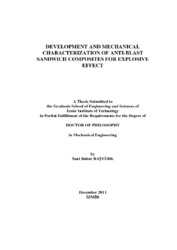Please use this identifier to cite or link to this item:
https://hdl.handle.net/11147/2909Full metadata record
| DC Field | Value | Language |
|---|---|---|
| dc.contributor.advisor | Tanoğlu, Metin | - |
| dc.contributor.author | Baştürk, Suat Bahar | - |
| dc.date.accessioned | 2014-07-22T13:48:35Z | - |
| dc.date.available | 2014-07-22T13:48:35Z | - |
| dc.date.issued | 2011 | - |
| dc.identifier.uri | http://hdl.handle.net/11147/2909 | - |
| dc.description | Thesis (Doctoral)--Izmir Institute of Technology, Mechanical Engineering, Izmir, 2011 | en_US |
| dc.description | Includes bibliographical references (leaves: 166-171) | en_US |
| dc.description | Text in English; Abstract: Turkish and English | en_US |
| dc.description | xix, 171 leaves | en_US |
| dc.description | Full text release delayed at author's request until 2015.01.25 | en_US |
| dc.description.abstract | Composite sandwich structures have high potential to be used in anti-blast armour systems due to their lightweight and resistance to explosive effects. This study focuses on the production and mechanical characterization of sandwich structures with aluminium (Al) foams of various thicknesses in conjunction with skins composed of Al/GFPP fibre/metal laminates. The bonding between the components of the sandwich was achieved by various surface modification techniques such as silane surface treatment, polypropylene (PP) adhesive film addition and their combination. The Al sheet/Al foam sandwiches were also prepared to investigate the effect of GFPP addition on the performance of sandwich structures. The energy absorption capacities together with compressive and flexural behaviour of both Al foams and FML/Al foam sandwiches were evaluated by flatwise compression and three point bending tests. The samples with higher elastic modulus usually exhibited higher collapse strength for each thickness set of foam and foam based sandwiches. Also, the core thickness increase led to the increase of overall flexural collapse load and GFPP presence promoted the strength of the sandwiches and dissipated energy values. In order to investigate the blast response of the sandwich panels, the quasi-static sandwich panel analysis was related to dynamic blast loadings. For this purpose, the sandwich composites were subjected to compression loading with a specially designed loading fixture and the corresponding test method is called as “simulated blast test”. The sandwiches were assumed as single degree of freedom mass-spring systems to include the dynamic effect. The peak deflections and survivability of the panels under blast loading were predicted based on the formulations reported in the literature. To evaluate the blast response of the monolithic materials, composites and sandwich panels, blast testing was performed using specially designed blast test frame system and 0.5 to 6 kg TNT explosives. Test results revealed that composites such as GFPP exhibited successful results against blast explosions. | en_US |
| dc.language.iso | en | en_US |
| dc.publisher | Izmir Institute of Technology | en_US |
| dc.rights | info:eu-repo/semantics/openAccess | en_US |
| dc.subject | Mechanical properties | en_US |
| dc.subject.lcsh | Composite materials--Mechanical properties | en |
| dc.subject.lcsh | Sandwich construction | en |
| dc.title | Development and Mechanical Characterization of Anti-Blast Sandwich Composites for Explosive Effect | en_US |
| dc.type | Doctoral Thesis | en_US |
| dc.department | Thesis (Doctoral)--İzmir Institute of Technology, Mechanical Engineering | en_US |
| dc.relation.publicationcategory | Tez | en_US |
| dc.identifier.wosquality | N/A | - |
| dc.identifier.scopusquality | N/A | - |
| item.fulltext | With Fulltext | - |
| item.openairecristype | http://purl.org/coar/resource_type/c_18cf | - |
| item.languageiso639-1 | en | - |
| item.grantfulltext | open | - |
| item.openairetype | Doctoral Thesis | - |
| item.cerifentitytype | Publications | - |
| Appears in Collections: | Phd Degree / Doktora | |
Files in This Item:
| File | Description | Size | Format | |
|---|---|---|---|---|
| 422201.pdf | DoctoralThesis | 6.54 MB | Adobe PDF |  View/Open |
CORE Recommender
Page view(s)
364
checked on Jul 21, 2025
Download(s)
432
checked on Jul 21, 2025
Google ScholarTM
Check
Items in GCRIS Repository are protected by copyright, with all rights reserved, unless otherwise indicated.